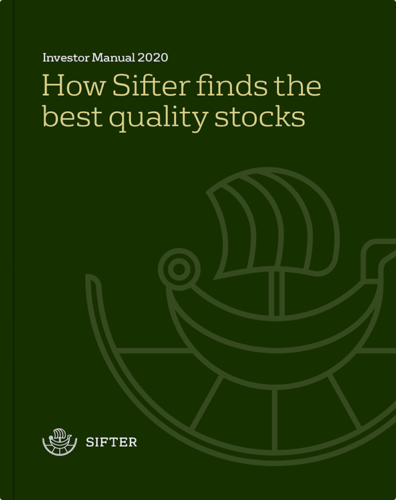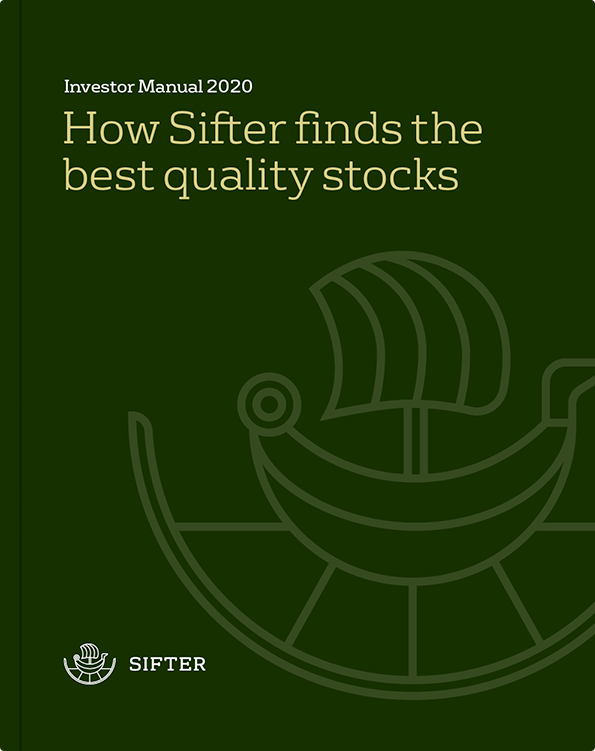For long-term investors, it´s an opportunity
Last year, our fund had an annual return of 31.3% after all fees. We achieved record-high returns for our investors. The coronavirus pandemic has quickly changed the picture. Long-term investors now have the opportunity to add high-quality companies to their portfolios at reduced prices.
What are the attributes that protect high-quality companies from the effects of the coronavirus crisis?
The contents of this page do not constitute investment advice or purchase recommendations for stocks. This page describes our opinions on the companies we have invested in or whose shares we have sold. The past performance of the fund is not a guarantee of future results.

We watch our investors’ backs. We are currently in the process of updating the profit forecasts of the companies in the Sifter portfolio. It goes without saying that the forecasts need to be adjusted, but only in the short term.
We have estimated that, on average, 50% of profits will be lost 2020 and, even next year, only about 80% of the previously expected profits will be achieved.
What is surprising is that, when we look at five-year forecasts, the companies in our portfolio look quite attractive.
Indeed, many of our investors have taken advantage of the downturn in the stock markets which has not spared high-quality companies and made additional investments in our fund.
The biggest change is that we can now buy the future cash flows of high-quality companies at a 30% discount.
At the start of the year, the five-year earnings yield (profit in fifth year divided by the current share price) has increased by one-third on average, from 5.2% to 6.7% (currently). By comparison, government bonds offer a guaranteed yield of less than 1%.
What is earnings yield?
It should be noted that the earnings yield does not represent the expected increase in share price, but rather the expected earnings we believe the companies offer us as shareholders if we invest one euro in the company at today’s share price.
Although there is still significant uncertainty in the forecasts for the companies we have invested in, the direction is clear.
This is the time to buy quality at low prices.
What is Sifter?
Sifter is an actively managed equity fund that invests in high-quality companies globally.
Sifter was established in Luxembourg in 2003, when Hannes Kulvik sought to invest his own wealth. When his circle of friends expressed a similar need, the fund was opened to the public. The founders and key persons behind the fund have stayed on as investors to this day.
Sifter Fund has three classes, with minimum investments of €100,000, €0.5 million and €5 million. Each class of the fund follows the same strategy, and the only differences between the classes are their subscription amounts and fees.
Three attributes that protect investors from turbulence
These attributes and examples are taken directly from Sifter Fund’s actual operations. They reflect the principles we apply in our investments and in looking after our investors’ wealth.
We focus on high-quality companies with low debt, a strong balance sheet and a good credit rating
A strong balance sheet is the best buffer against unexpected crises. When a company has a strong balance sheet, its operations are not acutely dependent on borrowed capital. When the company does need a loan, a good credit rating makes it possible to obtain the funds needed.
We prefer companies that are low in debt and even cash-rich. They offer peace of mind to investors, especially during times of unexpected crises.
A company with significant debts will see its problems accumulate in times of crisis and the cost of borrowing goes up. This weighs down on the company’s future profits and forces the management to shift its attention to the battle for survival.
The median net debt to EBITDA ratio of Sifter’s portfolio is 0.4x.
In other words, the companies Sifter invests in could pay off their debt in six months if their EBITDA remained unchanged.
The average net debt to EBITDA ratio for the companies that make up the S&P 500 index is 1.9x (31.3.2020).
The median credit rating of the companies in Sifter’s portfolio is A (S&P Global).
AN EXAMPLE FROM THE SIFTER PORTFOLIO
Koito Manufacturing
Koito Manufacturing is a Japanese company that is in Sifter’s portfolio. Koito is the world’s largest manufacturer of automotive lighting.
It is a leader in LED lighting and it has a dominant market share in automotive lighting for Toyota cars, in particular. Koito has 24 production facilities in 10 countries around the world.
In our view, Koito’s share price has dropped excessively due to the sudden slowdown in car manufacturing. We know that the company’s strong balance sheet will help it make it through this difficult time.


This is how we discover the best companies in 2020
Picking the best stocks from the global stock market is like looking for a needle in a haystack. At Sifter, we sift through over 65,000 companies worldwide – by no means a small feat.
In our partner investor manual, we explain how we find the best companies and implement our long-term investment strategy.
- Includes five tips for quality-oriented investors

This is how we discover the best companies in 2020
Finding the best stocks from the global stock market is like looking for a needle in a haystack. At Sifter, we sift through over 65,000 companies worldwide – by no means a small feat.
- Includes five tips for quality-oriented investors
We look for high-quality companies with high return on invested capital
Return on invested capital (ROIC) is one of the most important indicators for identifying high-quality companies. ROIC illustrates a company’s ability to create added value on the capital you invest.
When a company’s ROIC is at an excellent level, such as 15%, one euro invested in its operations generates €1.15 for the company.
The best companies do not distribute all of their profits to their shareholders. Instead, they invest part of their profits back in their business in order to further accelerate the growth of shareholder value.
This is why we consider the stocks of high-quality companies to be highly attractive and — in the long run — safe investments.
At the end of March, the median ROIC of Sifter’s portfolio was 15%. By comparison, the median ROIC of the S&P 500 index was 10%.
AN EXAMPLE FROM THE SIFTER PORTFOLIO
S&P Global Inc.
S&P Global Inc. is a global market leader whose services include credit ratings for bonds as well as market intelligence. The company’s best-known product is the S&P Dow Jones index.
In difficult times, the demand for loans increases, and creditors need credit ratings for borrowers — usually from two different rating agencies.
S&P Global has a strong market position in the credit rating industry. S&P’s ROIC has remained at a good level— above 30%— for the past five years.

We look for high-quality companies with predictable profits
The importance of predictability increases in hard times. The companies in the Sifter portfolio have clear revenue models and their cash flow is based on continuous services.
For example, for many high-quality companies that operate purely online, their business is 100% based on continuous invoicing. They also continuously increase the size of their contract base. The revenue of these companies is highly predictable, which means that they generate stable profits.
Steady revenue streams are also characteristic of industrial companies that provide continuous maintenance and update services for products over specific contract periods.
One example is Safran, a French company that manufactures aircraft engines and provides maintenance services for them. However, the risk with these companies is that investments may grind to a halt during a downturn.
AN EXAMPLE FROM THE SIFTER PORTFOLIO
Verisign Inc
Verisign, which manages .com and .net domain names, is a good example of a company that we want to have in our portfolio. Verisign’s profitability is second-to-none, as could be expected of a company that has the exclusive right to manage the world’s most popular domain names.
However, the annual cost of this to its customers is only around 10$, which is such a vanishingly small sum that few would even think about changing their domain name for this reason.
And none of its customers would ever think about abandoning their online presence, even if they needed to cut their costs. In fact, it would be the very last thing that they would ever consider doing.

AN EXAMPLE FROM THE SIFTER PORTFOLIO
Safran S.A.
Safran is a French company whose primary business is the manufacturing of aircraft engines. Safran has been in Sifter’s portfolio for a long time.
The predictability of Safran’s profit performance is based on its order backlog of approximately nine years (50% of sales) and the sales of continuous maintenance services.
Safran has a strong competitive position thanks to its industry-leading LEAP engine. The company’s business has been highly predictable for a long time and its industry is characterised by very high barriers to entry.

Timely tips for investors
Don’t try to time your buys perfectly
As an investor, you naturally want to add to your portfolio when the price is as low as possible. That’s easier said than done.
Predicting share prices in the short term is gambling. For a long-term investor, it is more important to take advantage of the opportunities presented by a downturn by making multiple buys than to time the bottom of the market perfectly.
The chances that you manage to buy the bottom of the market downturn are practically non-existent. The days of the highest price increases often come very quickly, and missing out on them is what really hurts you.
Remember the benefits of global allocation
Picking individual stocks may sound attractive in the current situation, with the share prices of many companies having dropped significantly.
However, if you are thinking about picking individual stocks, you need to keep in mind that it will expose you to company-specific and industry-specific risks. Sifter’s portfolio is diversified between 30 companies, 20 countries and 10 industries.
High-quality companies provide investors with peace of mind
While peace of mind is not something that a lot of investors are enjoying right now, it is one of the key advantages of being a long-term equity investor.
When you know that you own shares in high-quality companies that can make it through turbulent times, you don’t need to worry. Of course, share prices may decline sharply, but you know that it’s nothing new.
In the long run — over a ten-year horizon, for example — investing in high-quality companies has provided investors with annualised returns of 6–10% in almost every decade.
“For most asset managers, investing means betting for and against companies and focusing on current trends. Sifter’s calm approach is what sets it apart.”
Mika Mäkeläinen, serial entrepreneur
This is how we discover the best companies in 2020
Picking the best stocks from the global stock market is like looking for a needle in a haystack. At Sifter, we sift through over 65,000 companies worldwide – by no means a small feat.
In our partner investor manual, we explain how we find the best companies and implement our long-term investment strategy. There is no one key secret to our fund – read our manual to find out how we:
- Sift through the entire stock market
- Compare different companies
- Identify the best companies
- Monitor our investments
- 5 tips for quality-oriented investors

Download the manual
Sifter needs your contact information to stay in touch with you. You can leave our registers at any time. To find out more about our commitment to your privacy, read our Privacy Policy.